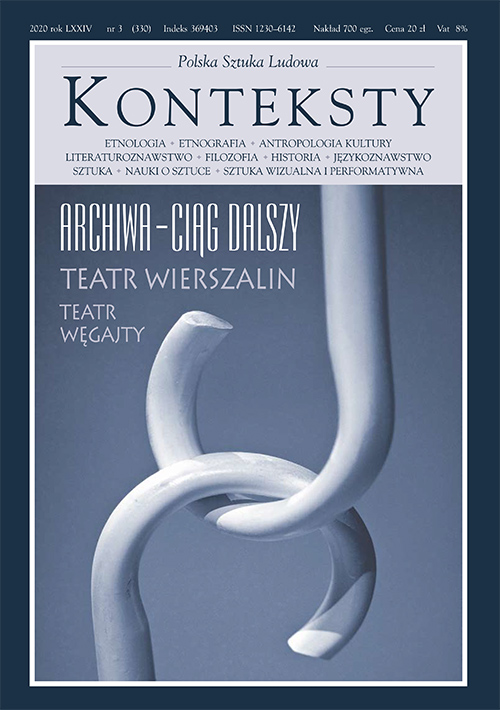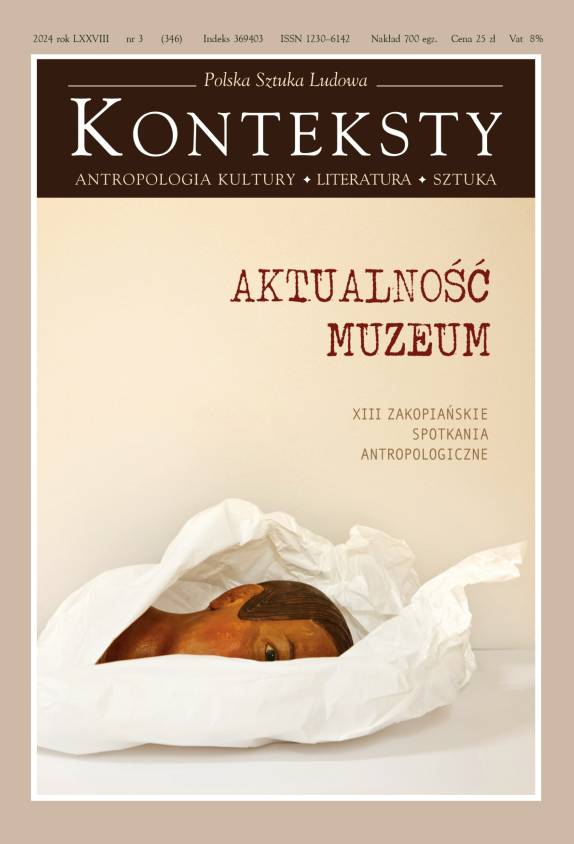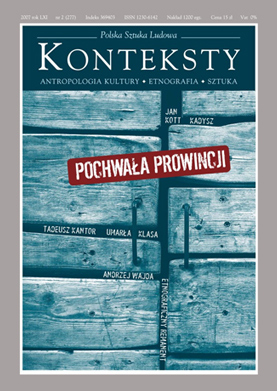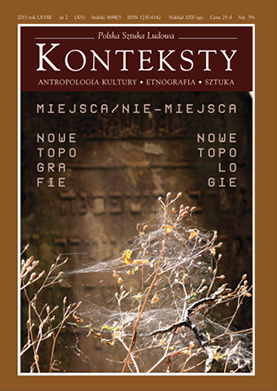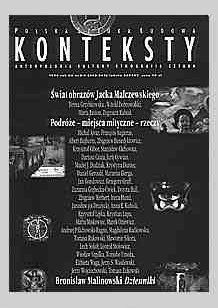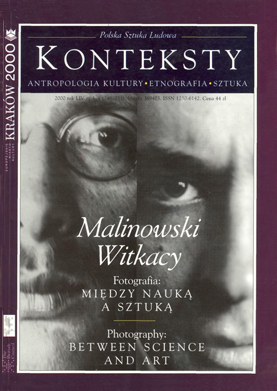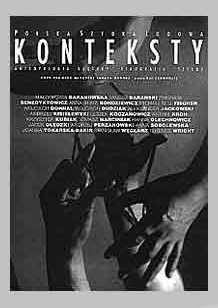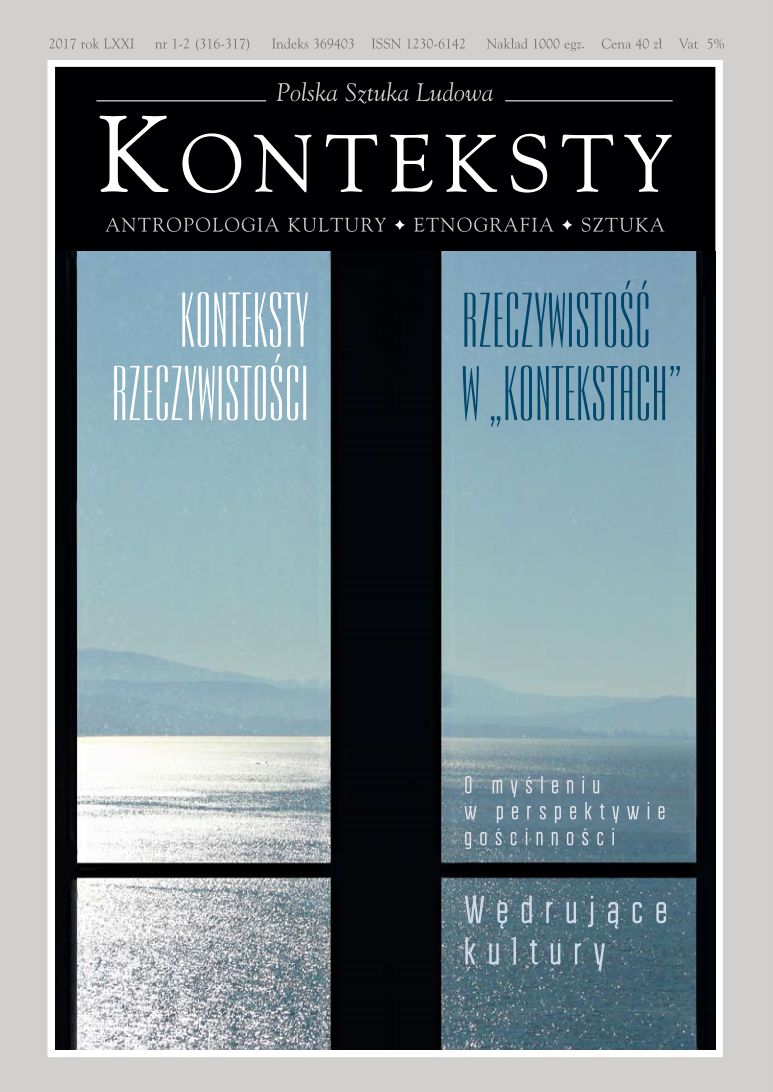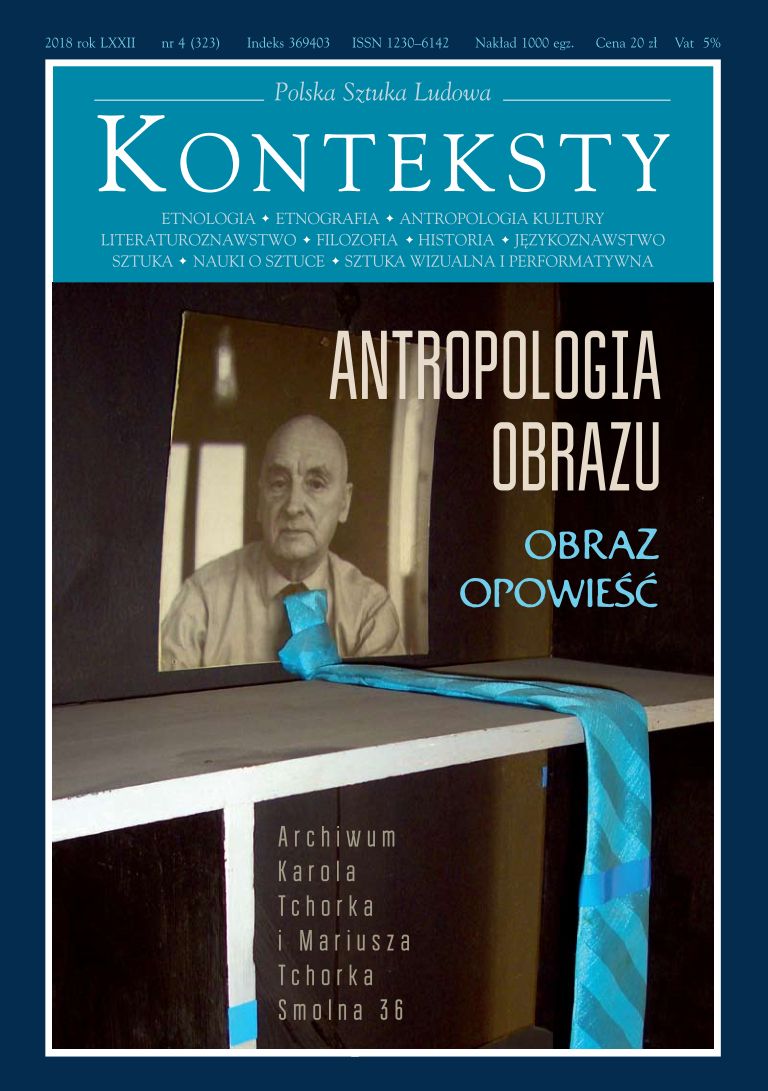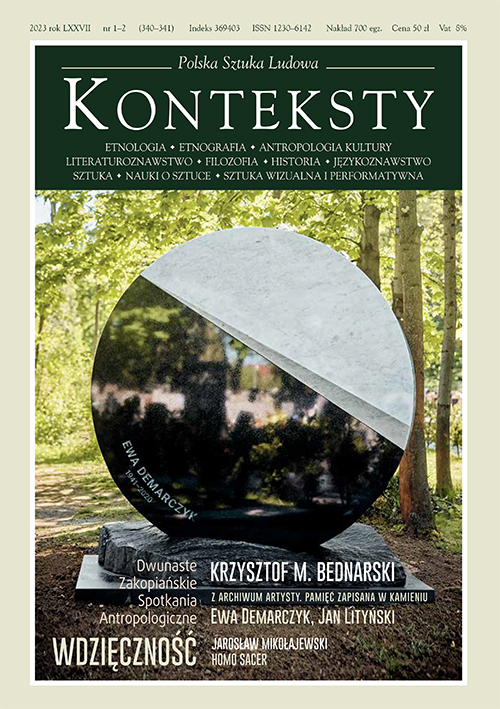Issue 2016/1 (312) -

| Paweł Próchniak | Wilderness. On a Poem by Jan Lechoń  | 3 |
This sketch is a contextual analysis and interpretation of one of the later poems by Jan Lechoń. Untitled and starting with: I rose naked from my dream... the poem in question is a record of a mysterious and disturbing vision composed of mutually penetrating iconic and sound structures, cultural topoi (such as manowiec/wilderness, clair de lune or nudity associated with death), universal figures of Judeo-Christian religious imagination (e.g. the Last Judgment and Purgatory) as well as strictly Polish components (Mt. Giewont or Gorzkie żale / Lenten Lamentations/ devotion). The author is interested in the poetic-musical architectonics and imaginary topography construed by Lechoń as well as all that, which comprises the intimate canvas of the spiritual experience inscribed into the poem | ||
| Dariusz Czaja | Music and Tears. A Hermeneutic Approach  | 11 |
Notes by Charles Darwin contain the surprising sentence: Crying is a puzzler. Why did the famous biologist discern a puzzle in tears? Why did he suggest unambiguously that evolutionistic rhetoric is incapable of explaining the process of crying? The author of this article is interested in the reason why tears appear in our experiencing of the world well as in their significance. Yet another issue seems to be even more important from an anthropological viewpoint: do tears deserve to be regarded as a reliable instrument of cognition? Common sense tells us that a tear masks perception. On the other hand, in certain situations tears break through to the other side of the visible, and the world perceived through their prism (including “the world next to us”) discloses previously unforeknown strata. | ||
| Michał Klinger | “Absent Presence” – In Search for a Hermeneutic Paradigm on the New Function of a Sign  | 21 |
The “next to world” is portrayed as an interpretation formula and a missing segment in the field of discovering textual meanings. It depicts a presence of sorts to which the text refers, but which does not occur in it directly, i.e. as in a film shot (the interpretation data of the text should, however, indicate the methodologically objective presence of the “next to world” in it). It offers signs and leaves traces in the text. The “Sign” is put forward as the terminus technicus of the phenomenon in question, but only as a “Sign” freed from semantic arbitrariness and designation function (e.g. the ”golden horn” in Wesele /The Wedding/ by Wyspiański). Such a “Sign”, as a rule, remains a metaphor nor does it explain anything in the text, but merely exists and only as such does it indicate the “next to world”. The author discussed the distinction between the “next to world” and the symbol, the allegory, and other traditional carriers of interpretation meanings, including Biblical ones – the Hebrew ot and the Greek typos. The “next to world” proves to be useful as an interpretation always on the borderline of semiosis. It is “to the ship as a coastline, to the shore as a ship”, it beckons and, at the same time, prohibits access. Its Signs “do not close up”, a feature that should be applied for distinguishing them from interpretation phenomena employed within the meaning system. Art is suffused with epiphanies of the “world next to us”, however small they might be. These are not “systemic”, e.g. theological epiphanies, because they remain on the borderline of semiosis and even outside the meta-level, and thus they do not take part in metaphysics but in mysticism at best. The author considered examples of the occurrence of the “next to world” and its Signs in the Holy Writ (certain epiphanies according to the Elohist Mosaic tradition) and assorted films by Kieślowski from the Decalogue series as well as La double vie de Véronique, examined in greater detail. Examples of poetry by, i.a. Leśmian and T. Różewicz serve an attempt at explaining the difference between the Signs of the “next to world” and other formal functions of the metaphor. An essential feature of the “next to world” Signs appears to be the fact that they “evade” interpretation within the range of the system contrary to the essence of the symbol, which is always ”within” the foundation of every system. Furthermore, the author discussed the hermeneutic determinants of those Signs within the context of, i.e. Sartre’s ontological reservations. Finally, he tried to apply the method using the “next to world” Sign for interpreting texts, mainly by the John the Apostle, about Mary/Magdalene fulfilling the “function of Antigone”. He also indicated the highly mysterious emotional Signs found in the Gospel: the anointing at Bethany, Mary of Magdala weeping next to the empty grave and “turning” in the Garden, and the Noli me tangere... Sign (John 20:17). The mysterious Presence permeates their “history of forms” and “edition”. The “absent present” is not a lack nor a gap to be filled, but a force (dynamis) of the Text. | ||
| Stanisław Krajewski | The Comprehensibility of the World  | 33 |
The progress of technology affects our image of the world. This holds true both for the uneducated, who readily resort to magic, and for scientists, who try not to succumb to magical thinking. Ordinary people remain in the middle. Technology makes our lives easier, but how does its progress impact the comprehension of the world? | ||
| Krzysztof A. Meissner | The Micro-world Within Us  | 39 |
A story about phenomena constantly occurring in every cell in our bodies, whose description is extremely distant from our experience, with language proposing totally imperfect and sometimes outright false associations and analogies, Nevertheless, even a flawed attempt at a description opens up a world not “dreamt of in your philosophy” and anthropology. | ||
| Tomasz Łączyński | Light Comes to Me. My World Next to Me  | 41 |
The world next to me has always existed. Do I seek creative themes in it? I believe that I unconsciously examine some sort of a world next to me, and benefit from it. Is this true? | ||
| Janusz Bohdziewicz | Entity and Non-fulfilment – or, on the Disillusioned World and Not So Forth  | 47 |
The challenge facing reflections (also anthropological ones) is not so much the “world next to us” as the increasingly universal (and outrageous) conviction that it is we who live more and more next to world. The author of this text intends to provoke the reader to ponder the paradox of the crisis (vision) of the world in an era of progressing globalisation eclipsing all ideas and worlds. The sources of this conflict-provoking paradox are disclosed upon the basis of conceptions expounded by Heidegger, Nancy, et al., as a consequence of a destruction of key concepts. The author maintains that his text does not propose a new world outlook but is to inspire a change in the way of thinking so that it would become possible to discern in global alienation some hope-stirring examples of post-secular existence. | ||
| Kuba Szpilka | On the Non-existence of the Jews, the Tubercular, and the Poor in the Beautiful World at the Foot of the Tatra Mts.  | 53 |
Who is the Other in Zakopane and what is his place in the Zakopane myth? The poor and the “lowlanders”, alongside the tubercular and the Jews, created the life of Zakopane on par with local residents or artists. Astonishingly, this mass-scale existence is devoid of representation, image, and story; it only occurs but never actually is. It exists apophatically via non-significance, non-essentiality, non-memory, non-shape, somewhere in the background and the backyard, far from the centre, and even if it should come into being in the latter its characteristic features are alien, non- native. This is why understood as an event Zakopane does not contain a prospect of a life of poverty, a Jewish plight, or existence marked with disease. It is overshadowed by a monumental and petrified holiday spirit or a vacation aura - the latter’s laicised form - and an accompanying carnivalisation of existence that suspends the order of daily life. This is the way in which Zakopane has been recorded and continues to create itself by making use of ever-new media. | ||
| Jan Gondowicz | Lowlanders  | 59 |
Lowlanders (cepry) pose a a genuine challenge for reflections on the ”phenomenon of Zakopane”, its meaning as a cultural project, and its place in the collective imagination of the Poles. Thousands of visitors flowing in and out of Zakopane and the Tatra Mts. comprise the true Great Alien and from the vantage point of the local residents - the invisible (mass-scale) man, thanks to whom, nonetheless, and under whose pressure the mentioned phenomenon continues and is subject to change. Probably nowhere in the olden and new “resort towns” of Europe has the antagonism between the local residents and the visitors been elevated to such a degree within a curious mythologisation. What did the ”lowlanders” and the ”town-dwellers” perceive and were capable of comprehending when confronted with Zakopane and the Tatras – this is a prominent question to which no one has so far discovered an answer. Scorned, they maunder next to us (the presumably superior local inhabitants), vanish, and then, in the manner of some natural phenomenon, reappear – after all, Zakopane would simply not exist without its cepry. | ||
| Monika Sznajderman | Book of Radom – Tale of an Invisible Town  | 63 |
Alongside the physically existing town of Radom there is a second borough, visible only to some but, nonetheless, just as real. This is the Radom of material traces and some sort of a ghostly life; in it, the dead continue to pursue their phantom existence. The symbol of this absent presence is not something but naught – emptiness instead of the now windswept former Jewish district. It is also a strange phantom pain that assaults the author from time to time, whenever she thinks about all of them. This is a world next to us and within us, a world that grows deep within, penetrates, becomes part of us, and inflicts wounds. In this world the author’s deceased still live, although she is aware that they all perished at the time of the Holocaust and that the only surviving member of her whole family, Elias Sznajderman, left, never to return, in August 1945, a day after a pogrom carried out in the “Praca” cooperative. | ||
| Piotr Jakub Fereński | In-visible  | 71 |
In the middle of 2009 the author joined a group of researchers from the Adam Mickiewicz University in Poznań to cooperate with representatives of other Polish scientific institutions pursuing “The Invisible Town” project. The titular “invisibility” stemmed from the fact that the studies conducted within the project pertained to those elements of the socially/culturally generated urban reality whose “physical dimension” remains visible but on a daily basis is unnoticed by the residents. This is a world next to us, but one that is overlooked. The article contains several remarks concerning the project in question. | ||
| Katarzyna Prot-Klinger | The Psychotic ”Next to World”. Psychosis as a Way of Communicating with the World  | 77 |
The psychological “next to world” is the world of psychosis, a world parallel to surrounding reality. Persons suffering from psychosis often speak about the existence of “a second world”, which can be terrifying but also tempting. This is a world based on other principles than the ones of the world experienced on a daily basis. A description of that world is served by figures and symbols from the realm of culture – in the past these were mainly religious symbols, and at present they are the products of mass culture (such as the “world of Hogwart”). From the Freud era psychologists and psychiatrists tried to understand the narrations of their psychotic patents. Today, the attitude towards patients experiencing psychosis reveals two approaches. One is strictly biological and considers ”psychosis as an illness”, with all the consequences of this strictly medical method. The other regards psychosis to be a language that we may attempt to understand. The author of this text intends to demonstrate upon assorted examples the possibility of comprehending psychosis and the method of treating it based on dialogue and its Bakhtinesque “polyphonic quality”. | ||
| Dorota Koczanowicz | Banquets and Leftovers  | 83 |
The kitchen is situated next to the reception rooms and is often separated from them so as to avoid all contact with cooking smells and repellent leftovers. This is the domain of a sui generis dialectic of attraction and repulsion, since although the kitchen is a hinterland of the banquet it becomes crowded with guests who wish to take a break from the elegance of the sitting room. The kitchen also attracts many contemporary artists. The author of this text concentrated on examples of artistic activity pursued far from the space of art sanctified by tradition. An artist’s entry into a kitchen is an act of contesting traditional divisions into art and life, overstepping conventions, leaving the stage, and vanishing in the wings. Artists cook for assorted reasons. They reach for food because they seek a convenient binder of a temporary community, stand up for women “imprisoned” in kitchens, seek new fields for beauty or, on the contrary, challenge traditional aesthetic values. | ||
| Aleksandra Janus | Vacation Greetings. A Postcard from the Island of Sylt  | 91 |
The article analyses the exhibition: "Reinefarth in Warsaw. Evidence of Crime” (Museum of Wola, branch of the Museum of Warsaw, 2014/2015) against the backdrop of exposition strategies dominating in Polish historical exhibitions conceived in recent years. The text, however, deals not only with the visual construction of the display but also its reception and impact upon the visitors. In doing so, it refers to initial results of studies of the public conducted upon this occasion and during three other historical exhibitions in various ways pertaining to the Second World War and on show in Poland after 2004. | ||
| Małgorzata Sady | Notes to a Brief Story about the Life and Works of the Themersons | 97 |
| Małgorzata Sady | The Themersons – Film and Story | 100 |
| Wojciech Majewski | My “Next to” Film Worlds  | 103 |
A story about Silesia – a fascinating “next to world”, the Silesian home and its tradition. The author directed a documentary firm: The Home in Silesian Tradition. | ||
| Krystian Darmach | Nighttime Perversions. The Irresistible Urban OFFer  | 109 |
Night. Town. People. People in a town at night. In this text the author observed the configuration of relations between the above categories. Upon the example of OFF PIOTRKOWSKA, an alternative culture venue located in Łódź, he attempted to demonstrate the course of the revitalisation of this particular spot and its re-introduction into the cultural circuit of the significant forms and contents of city life. While endeavouring to describe the parameters characterising the night as a cultural category the author took a closer look at urban space with a specific history of its own and transformations occurring under the impact of mutually connected economic factors associated with a global flow of information, fashion, and pop-cultural trends relating to the urban lifestyle, all instilled into local contexts (in this particular case - those of Łódź). The text refers to the town’s history at the time when it flourished as an industrial centre as well as to its most recent past so as to show the various forms and meanings, which this concrete space (a former factory quarter) in Piotrkowska Street acquired. From a workplace, an abandoned dystopia, and a non-place it revolved into a space acclaimed to be one of the Polish wonders of the world, which every Friday night resonates with sounds, music, conversations, and fun, shimmers with colours and scents, and which by constantly assuming new forms fulfils the requirements and anticipations both of its residents and the owners of the entertainment complex. | ||
| Nikodem Karolak | Revolutionary Worlds. Adult Hunting by Terayama Shūji – from a Children’s Revolt to the Birth of Emperor Tomato Ketchup  | 114 |
The article focuses on one of the most disturbing Japanese radio plays: Otona-gari (Adult Hunting, 1960) and its film adaptation: Tomato Kechappu Kōtei (Emperor Tomato Ketchup, 1971), both surrounded with an aura of scandal. The director of the two works, Terayama Shūji (1935-1983), a highly influential representative of the Japanese twentieth-century theatre-cinematic avantgarde, proposed a dystopic image of the disintegration of society, in which children mercilessly slaughter adults and set up a marionette state headed by the titular emperor. The Japanese director confirmed his predilection for intertextualisation: his works are collages, both as regards realisation (assorted types of montage, a mixed sound track) and ideology (numerous borrowings from European philosophy). Terayama created a world comprising a mixture of the high and low in the vein of the Bakhtian conception of carnivalisation, and although at times his sense of the absurd is comical the resultant entity is invariably pessimistic. The world created as an outcome of a brutal children’s revolt cannot possess a prolonged raison d’être and is doomed to constant transformations set into motion within a vicious circle of recurring revolutions. | ||
| Justyna Chmielewska | Polish Greek and Roman Mythology  | 118 |
A photo essay about the non-obvious presence of Greek and Roman mythological figures in the mundane Polish landscape. The author finds the traces of ancient gods, goddesses, heroes and monsters among tiny shops in remote villages, suburban motels and office buildings in the very center of Warsaw, thus showing the paradoxical heterogeneity of symbols present in our everyday lives. | ||
| Paweł Orzeł | On „Środek świata w Skierniewicach” | 125 |
| Marta Zelwan | The Centre of the World in Skierniewice  | 127 |
A commentary to Środek świata w Skierniewicach by Marta Zelwan and, predominantly, Oniriada (1997) – a selection of accounts of dreams by Henryk Bereza from 1976-1996. "The centre of the world is a place from which all roads run in every direction and where they converge, a place of the beginning, untouched, a place situated everywhere, earlier than all others and remembering all others. In Oniriada by Henryk Bereza, in his dreams, I seek that place in the region of Skierniewice. There, the centre gradually discloses itself and an entrance opens“. | ||
| Henryk Bereza | Wyprawa skierniewicka  | 129 |
Fragment of Zapiski by Henryk Bereza (12-13 July 1980). | ||
| Paweł Kuligowski | Vita est vigilia. An Essay on Eschatology and Its Substitutes  | 131 |
A reconstruction – and a critique – of modern Western eschatological and futurological sensitivity, with the essay situating associated conceptions of possible knowledge about the future on a scale spanning between four “singular points”: the future conceived as an object of resignation, anticipation, horror, and knowledge sensu stricto. These points, although possessing the nature of ahistorical ideal types, are designated and discussed in the course of an analysis of select – essential – fragments of Western literature, both high (Horatio, St. Paul) and popular (Dick, Asimov). | ||
| Paweł Drabarczyk | Loftiness. Reactivation  | 141 |
More and more seems to indicate that a return of the category of loftiness can be the object of interest for an historian dealing with Polish contemporary art and that the concept in question continues to assume ever new contents here and now. Naturally, the present-day reoccurrence of loftiness takes place against the backdrop of the astonishing worldwide career enjoyed by the titular concept in recent decades. The author of the article, which is a brief review of assorted current artistic realisations conducted from a sublimicising viewpoint, ponders the course and formula in which this category renders its presence known in art and pertinent statements. Apparently, on the Polish contemporary scene loftiness returns in a specific edition vividly tinted with the intuition of a catastrophe. | ||
| Łukasz Tischner | Religious Reflections of Charles Taylor  | 149 |
The article pertains to those aspects of the philosophy of Charles Taylor that constitute his ”religious reflections”. At the onset Tischner considered the degree to which one may describe Taylor’s reflections as ”post-secular”. Subsequently, he outlined three domains of the philosophy of the author of A Secular Age: his conception of the language of epiphany and the parabola, which open up to a certain higher reality, analyses of experiencing agape/karuna, and, finally, descriptions of the phenomenon of kenoza/anatta. According to Tischner, Taylor wishes to indicate common points linking Buddhist tradition and Christianity. A summary recalls those religious thinkers with whom Taylor conducts a dialogue. | ||
| Renata Rogozińska | “How We Remember Thus We Shall Be Remembered”. The Art of Janusz Marciniak and the Holocaust  | 155 |
The interest in the tragedy of Shoah demonstrated by Janusz Marciniak, although not devoid of personal motivations, coincided with the emergence of art conceived as “a discourse about the past”. German genocide treated as the most grievous crisis of history and rationalism is the object of a particularly in-depth debate, not merely artistic but also historical, philosophical, and sociological. Today, grief and commemoration of the Holocaust continue to function in Poland as a constant element of culture. Contrary to his oeuvre from the last two decades of the twentieth century, whose characteristic features include a considerable dose of painterly expression, Marciniak avoids affectation in his works dedicated to the Holocaust and is concerned with concise statements. Instead of an art of “the cry and suffering”, revealing the presence of fear, dread, and catastrophe, he proposes the poetic of calmness and reflections, and prefers to the artistic experiment the transparency of the document, the discipline of the text, and finally, the digital image, which became helpful in ridding the gesture of all rhetorical features, depersonalizing the visual stratum, and freeing activity via the image. Both in his undertakings pursued in the building of the public swimming pool in Poznań – originally a synagogue, and in monument projects and realizations an evocative visual effect was created with the assistance of simple means of expression and lucid metaphors. Due to their transparency they referred the recipient to his previous knowledge about the Holocaust and the life of the Jews in Polish lands, to the stories and images carried by all of us. The most essential has not been said, presented or enacted. It came into existence “between” and lasted outside all words. The works of the Poznań-based artist dealing with the Holocaust thus became part of a discourse about the “non-presentability of the Holocaust”, initiated by Theodor Adorno’s famous declaration about writing poetry after the barbarity of Auschwitz. | ||
| Paweł Dybel | The Emancipatory Message of Psychoanalysis according to Roman Markuszewicz upon the Basis of His Early Works  | 162 |
A presentation against a broad cultural-historical backdrop of early works by Roman Markuszewicz, an outstanding, and today forgotten, Polish pre-war psychiatrist and neurologist. The point of departure consists of texts about Freudian psychoanalysis, indicating the original nature of this theory and accentuating its emancipatory claim focused on the patient’s self-knowledge. This claim was linked with hope for creating in the future a new type of society, in which the individual could, by getting rid of his inhibitions and complexes thanks to psychoanalysis, make better use of his drive energies. In other words, Freud’s theories assisted Markuszewicz in building a social utopia, which, however, broke down in the second half of the 1920s. | ||
| Magdalena Barbaruk | The Multiplicity of Worlds  | 170 |
The author deliberated on the reasons why La Mancha, the central and most recognizable region of Spain, is simultaneously a “next to“ world, i.e. different, unknown, and provincial, a Schulzian “Republic of Dreams”. Essential importance is ascribed to the fact that the most celebrated although fictional inhabitant of this region was the knight errant Don Quixote. The article depicts the symptoms and possible causes of the constant marginalisation and peripherialisation of works of Spanish culture in the humanities. | ||
| Michał Kurkowski | “I”. Concerning The Ugly Duckling by Hans Christian Andersen  | 177 |
In the essay the author deals with The Ugly Duckling, one of the most celebrated tales by Hans Christian Andersen. By interpreting it from a biographical vantage point, indicating personal motifs in the plot, and resorting to the tradition of studying the tale, initiated by Bruno Bettelheim, M. Kurkowski refers to Jung, Freud, Adler, Hellinger, and Kazimierz Dąbrowski; at the same time, he tries to refer to Andersen’s other texts, his autobiography, and the canonical biography by Jackie Wullschlager. In doing so, the author of the essay perceives The Ugly Duckling as a story about the birth of an individual’s identity, handicapped in the initial stage but slowly overcoming successive obstacles so as to achieve natural beauty. At the same time, emphasis is placed on the fact that as children we are all such ducklings prone to complexes, and our failed attempts at showing off shape our personality and prepare us for a confrontation with the world of adults. | ||
| Agnieszka Koecher-Hensel | A Return to the Family Home in Bronice  | 187 |
The history of a manor house in Bronice, which for almost a century belonged to the Wołk-Łaniewskis, the author’s ancestors. Today, the residence has been restored to the family and became the scene of theatrical events. | ||
| Ewa Mrozek-Rodzikowa | The Theatre and Christmas Eve in Bronice  | 196 |
A story about the amateur theatre in Bronice, including the present-day Ritual Ensemble. | ||






















